Torrens University: MIS602 Data Modelling & File-Based Database Design
VerifiedAdded on 2022/08/21
|10
|1487
|11
Report
AI Summary
This report details the data modeling and database design process for a student course enrollment scenario at Torrens University Australia (TUA), utilizing a file-based system with Excel spreadsheets. The report begins with an introduction to data modeling and file-based database systems, highlighting their structure and functionalities. It then explores data attributes essential for storing student information, course details, and staff assignments. The core of the report showcases the design evolution through four versions of the Excel-based database, detailing attribute additions, modifications, and removals to optimize the system. The report concludes by comparing file-based systems with structured database systems, emphasizing the longevity, consistency, and practicality of file-based approaches for smaller organizations and specific applications. The document meticulously outlines the design process and various versions of the database to provide a comprehensive understanding of data modeling and database design principles.
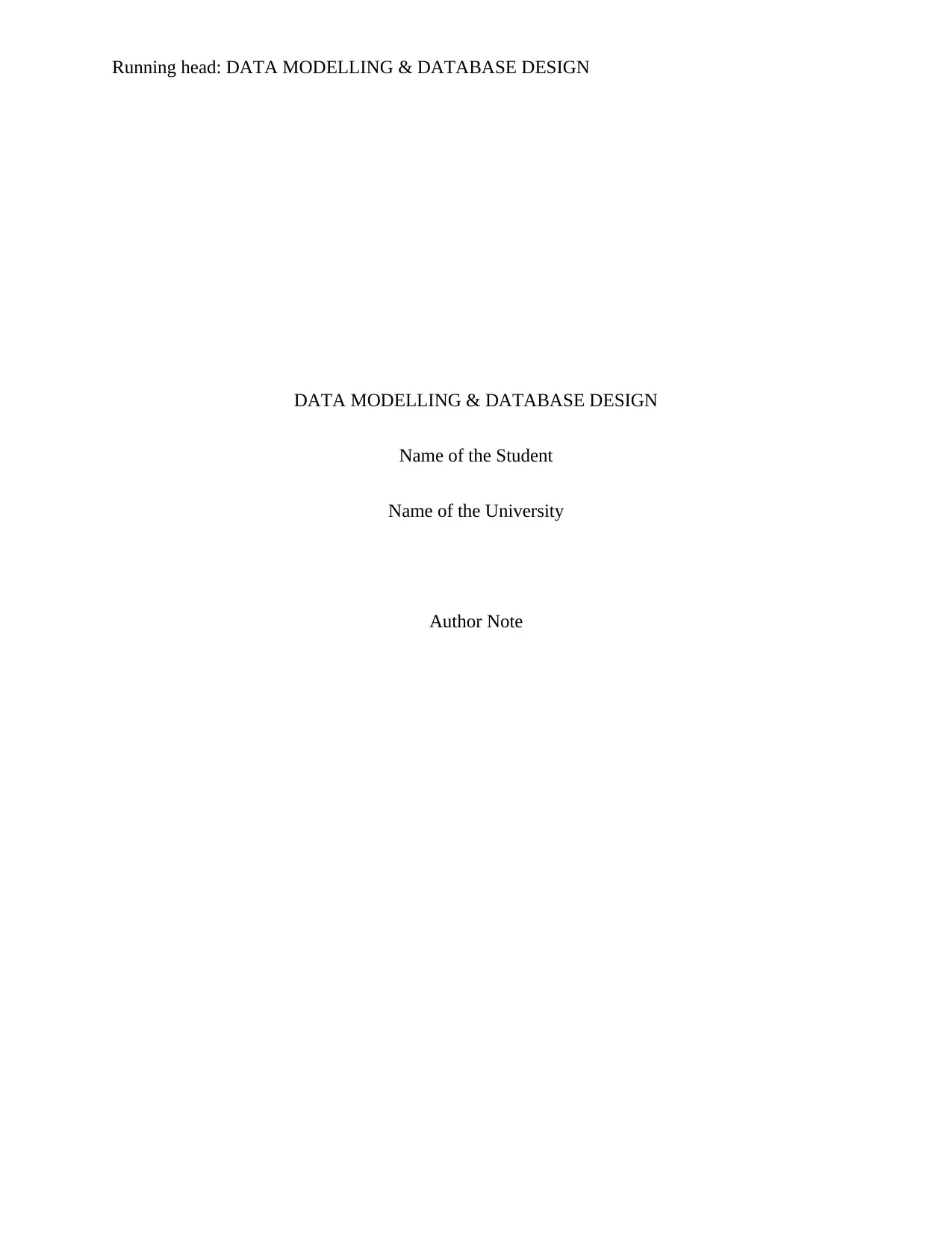
Running head: DATA MODELLING & DATABASE DESIGN
DATA MODELLING & DATABASE DESIGN
Name of the Student
Name of the University
Author Note
DATA MODELLING & DATABASE DESIGN
Name of the Student
Name of the University
Author Note
Paraphrase This Document
Need a fresh take? Get an instant paraphrase of this document with our AI Paraphraser
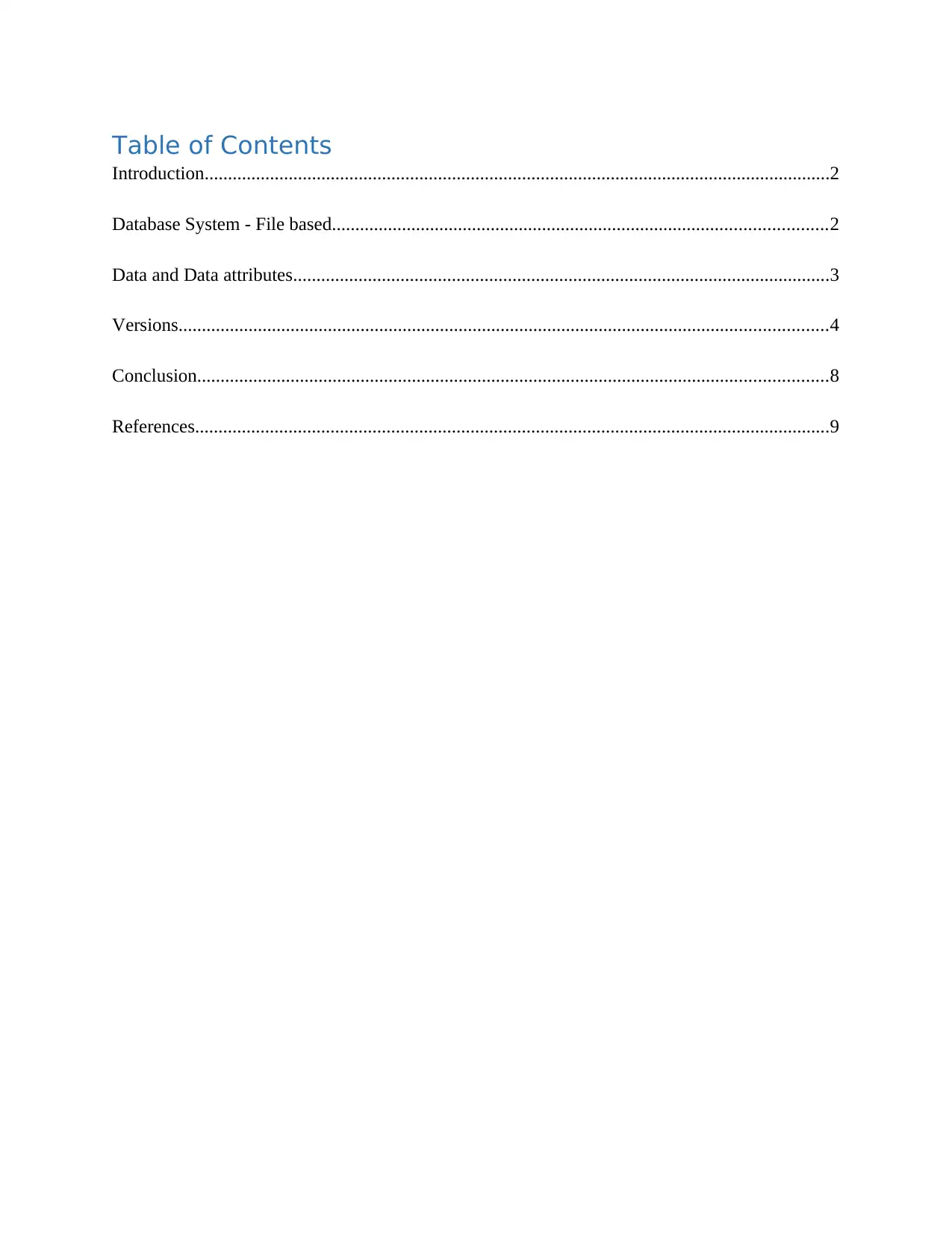
Table of Contents
Introduction......................................................................................................................................2
Database System - File based..........................................................................................................2
Data and Data attributes...................................................................................................................3
Versions...........................................................................................................................................4
Conclusion.......................................................................................................................................8
References........................................................................................................................................9
Introduction......................................................................................................................................2
Database System - File based..........................................................................................................2
Data and Data attributes...................................................................................................................3
Versions...........................................................................................................................................4
Conclusion.......................................................................................................................................8
References........................................................................................................................................9

Introduction
Data modeling is the initial phase of the database design, considered as the high level
design phase. The main of the modeling is to define data related to the entities inspired from the
real word objects. The structure of the database is developed in the modelling phase with the
help of entities, attributes and relationship between them. However, the flat file based databases
are developed using normal text or excel files (Bowcock & Bayfield, 2014). These files are also
helpful in storing information earlier than the Structured databases (SQL). Attributes are
essential for the data storing where it defines the column that what kind of data will be saved. In
this document, the data modelling of a student course enrolment scenario will be explained with
the help of excel. It will allow the staff to add, update and delete the data from the files whenever
required. Lastly the document will finalize with the results of the Excel assessment.
Database System - File based
The database system that uses data files to organize and manage data is known as file-
based database management system. It is supposed to handle only one data file at a time. It is the
easiest form of database system to handle as structure is consistent and software for handling
these files are inexpensive (Winston, 2016). It is mainly used in smaller organizations or by
home users. It best for storing less amount of data which makes the data retrieval faster and easy.
However, the data security, integrity and management of large data is not suitable for file based
system. Each domain data is stored in separate files which is accessible by other software also.
The main functionalities of the file-based database system is given below:
i. The data can be managed by any user as it is simple to get access and use.
Data modeling is the initial phase of the database design, considered as the high level
design phase. The main of the modeling is to define data related to the entities inspired from the
real word objects. The structure of the database is developed in the modelling phase with the
help of entities, attributes and relationship between them. However, the flat file based databases
are developed using normal text or excel files (Bowcock & Bayfield, 2014). These files are also
helpful in storing information earlier than the Structured databases (SQL). Attributes are
essential for the data storing where it defines the column that what kind of data will be saved. In
this document, the data modelling of a student course enrolment scenario will be explained with
the help of excel. It will allow the staff to add, update and delete the data from the files whenever
required. Lastly the document will finalize with the results of the Excel assessment.
Database System - File based
The database system that uses data files to organize and manage data is known as file-
based database management system. It is supposed to handle only one data file at a time. It is the
easiest form of database system to handle as structure is consistent and software for handling
these files are inexpensive (Winston, 2016). It is mainly used in smaller organizations or by
home users. It best for storing less amount of data which makes the data retrieval faster and easy.
However, the data security, integrity and management of large data is not suitable for file based
system. Each domain data is stored in separate files which is accessible by other software also.
The main functionalities of the file-based database system is given below:
i. The data can be managed by any user as it is simple to get access and use.
⊘ This is a preview!⊘
Do you want full access?
Subscribe today to unlock all pages.

Trusted by 1+ million students worldwide
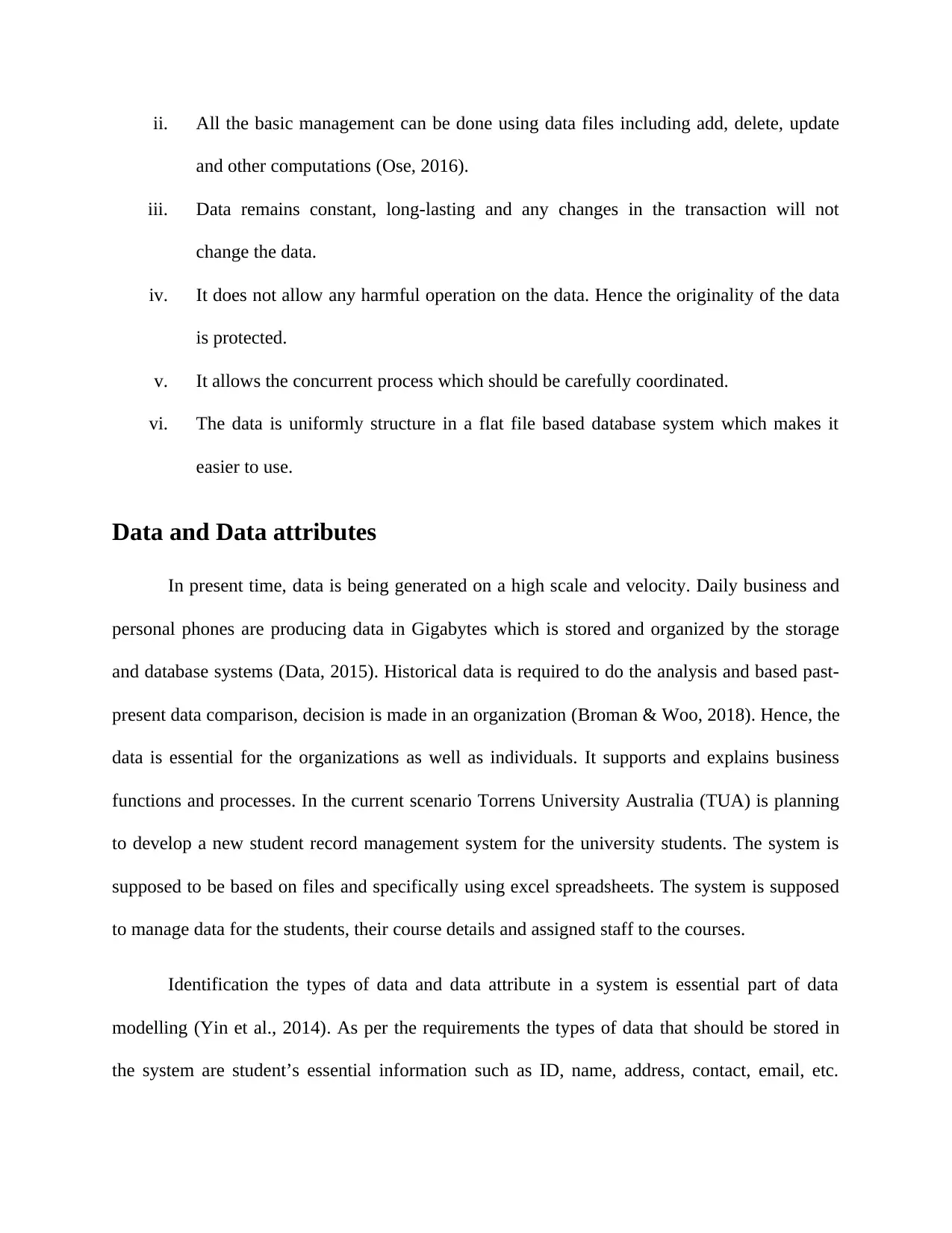
ii. All the basic management can be done using data files including add, delete, update
and other computations (Ose, 2016).
iii. Data remains constant, long-lasting and any changes in the transaction will not
change the data.
iv. It does not allow any harmful operation on the data. Hence the originality of the data
is protected.
v. It allows the concurrent process which should be carefully coordinated.
vi. The data is uniformly structure in a flat file based database system which makes it
easier to use.
Data and Data attributes
In present time, data is being generated on a high scale and velocity. Daily business and
personal phones are producing data in Gigabytes which is stored and organized by the storage
and database systems (Data, 2015). Historical data is required to do the analysis and based past-
present data comparison, decision is made in an organization (Broman & Woo, 2018). Hence, the
data is essential for the organizations as well as individuals. It supports and explains business
functions and processes. In the current scenario Torrens University Australia (TUA) is planning
to develop a new student record management system for the university students. The system is
supposed to be based on files and specifically using excel spreadsheets. The system is supposed
to manage data for the students, their course details and assigned staff to the courses.
Identification the types of data and data attribute in a system is essential part of data
modelling (Yin et al., 2014). As per the requirements the types of data that should be stored in
the system are student’s essential information such as ID, name, address, contact, email, etc.
and other computations (Ose, 2016).
iii. Data remains constant, long-lasting and any changes in the transaction will not
change the data.
iv. It does not allow any harmful operation on the data. Hence the originality of the data
is protected.
v. It allows the concurrent process which should be carefully coordinated.
vi. The data is uniformly structure in a flat file based database system which makes it
easier to use.
Data and Data attributes
In present time, data is being generated on a high scale and velocity. Daily business and
personal phones are producing data in Gigabytes which is stored and organized by the storage
and database systems (Data, 2015). Historical data is required to do the analysis and based past-
present data comparison, decision is made in an organization (Broman & Woo, 2018). Hence, the
data is essential for the organizations as well as individuals. It supports and explains business
functions and processes. In the current scenario Torrens University Australia (TUA) is planning
to develop a new student record management system for the university students. The system is
supposed to be based on files and specifically using excel spreadsheets. The system is supposed
to manage data for the students, their course details and assigned staff to the courses.
Identification the types of data and data attribute in a system is essential part of data
modelling (Yin et al., 2014). As per the requirements the types of data that should be stored in
the system are student’s essential information such as ID, name, address, contact, email, etc.
Paraphrase This Document
Need a fresh take? Get an instant paraphrase of this document with our AI Paraphraser
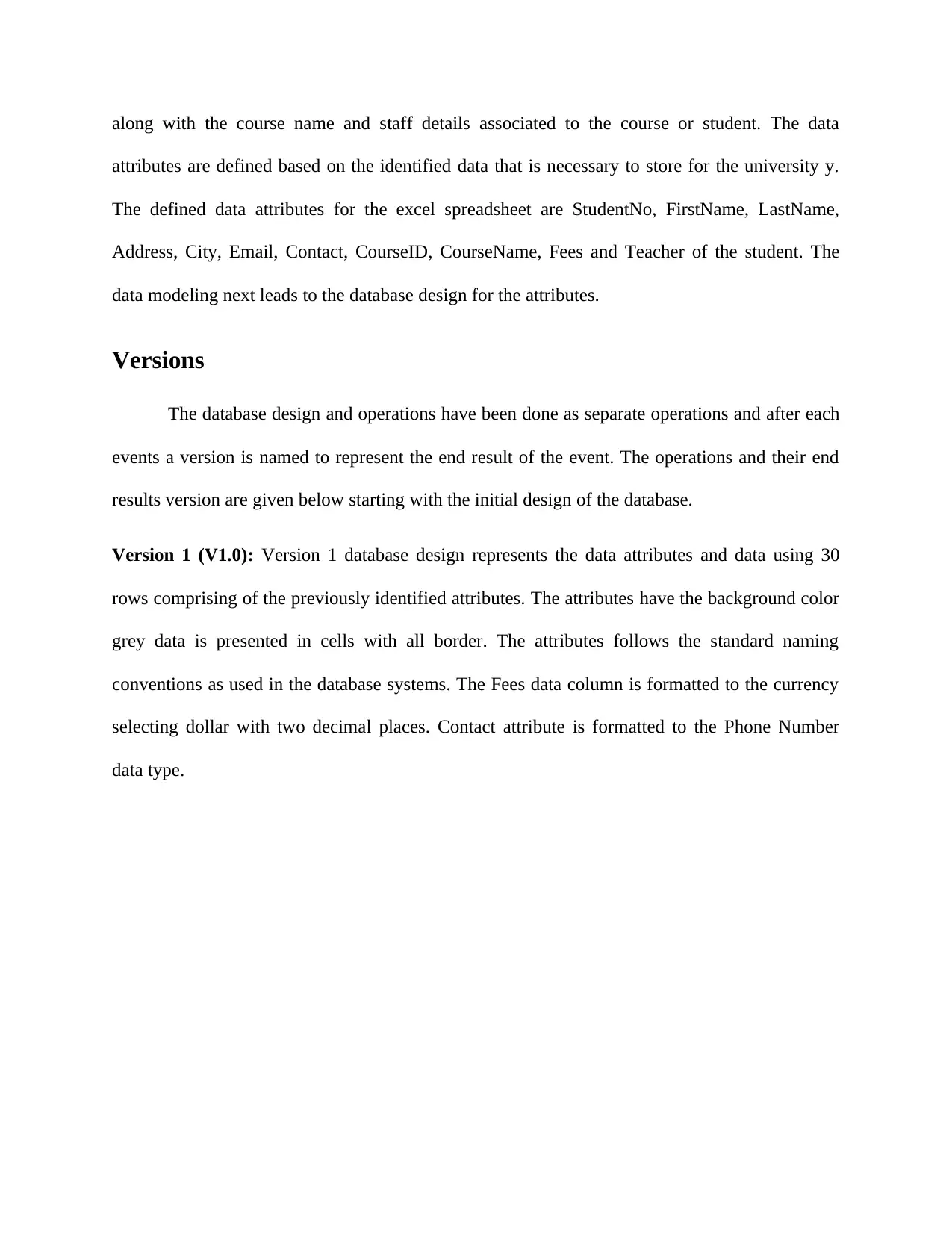
along with the course name and staff details associated to the course or student. The data
attributes are defined based on the identified data that is necessary to store for the university y.
The defined data attributes for the excel spreadsheet are StudentNo, FirstName, LastName,
Address, City, Email, Contact, CourseID, CourseName, Fees and Teacher of the student. The
data modeling next leads to the database design for the attributes.
Versions
The database design and operations have been done as separate operations and after each
events a version is named to represent the end result of the event. The operations and their end
results version are given below starting with the initial design of the database.
Version 1 (V1.0): Version 1 database design represents the data attributes and data using 30
rows comprising of the previously identified attributes. The attributes have the background color
grey data is presented in cells with all border. The attributes follows the standard naming
conventions as used in the database systems. The Fees data column is formatted to the currency
selecting dollar with two decimal places. Contact attribute is formatted to the Phone Number
data type.
attributes are defined based on the identified data that is necessary to store for the university y.
The defined data attributes for the excel spreadsheet are StudentNo, FirstName, LastName,
Address, City, Email, Contact, CourseID, CourseName, Fees and Teacher of the student. The
data modeling next leads to the database design for the attributes.
Versions
The database design and operations have been done as separate operations and after each
events a version is named to represent the end result of the event. The operations and their end
results version are given below starting with the initial design of the database.
Version 1 (V1.0): Version 1 database design represents the data attributes and data using 30
rows comprising of the previously identified attributes. The attributes have the background color
grey data is presented in cells with all border. The attributes follows the standard naming
conventions as used in the database systems. The Fees data column is formatted to the currency
selecting dollar with two decimal places. Contact attribute is formatted to the Phone Number
data type.
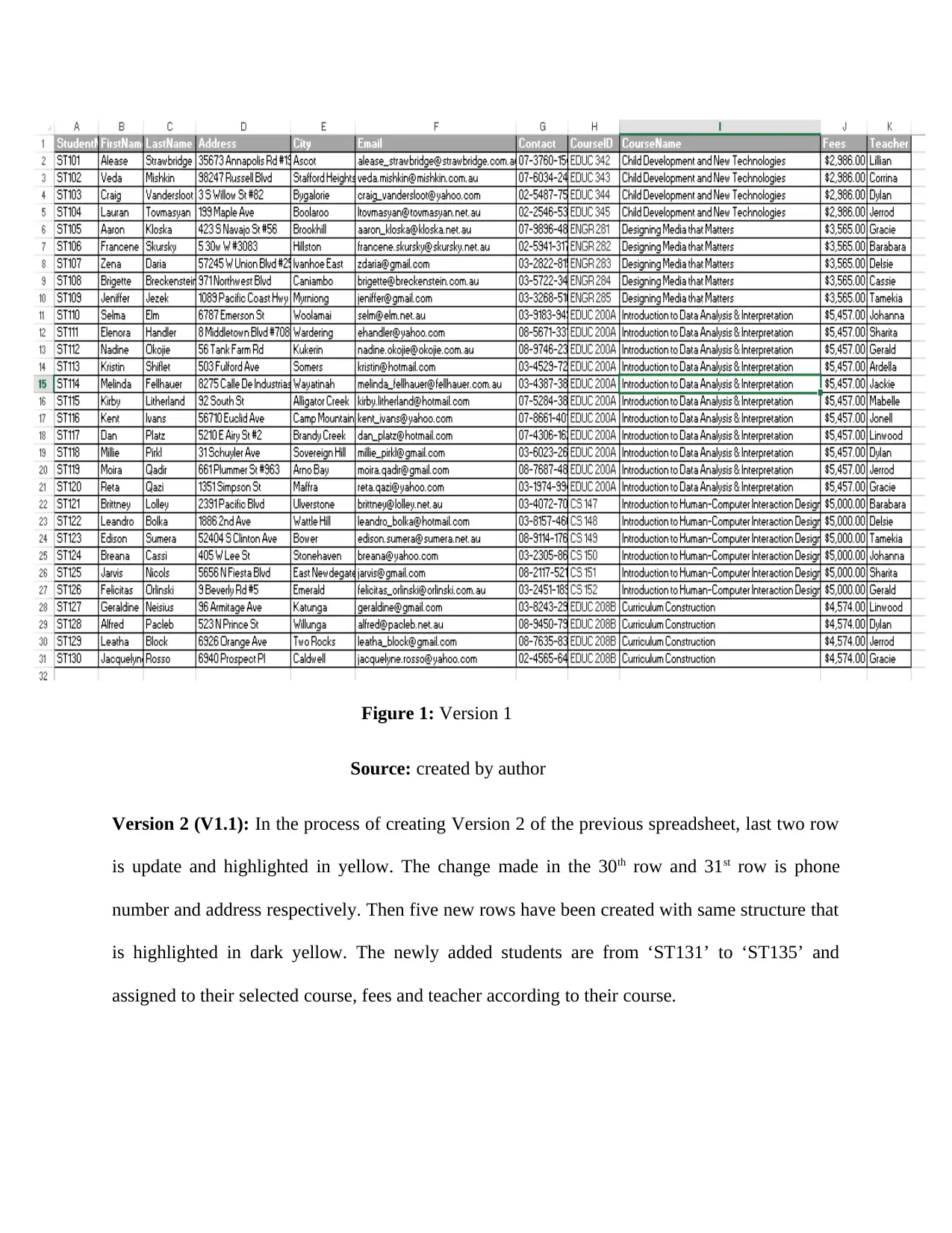
Figure 1: Version 1
Source: created by author
Version 2 (V1.1): In the process of creating Version 2 of the previous spreadsheet, last two row
is update and highlighted in yellow. The change made in the 30th row and 31st row is phone
number and address respectively. Then five new rows have been created with same structure that
is highlighted in dark yellow. The newly added students are from ‘ST131’ to ‘ST135’ and
assigned to their selected course, fees and teacher according to their course.
Source: created by author
Version 2 (V1.1): In the process of creating Version 2 of the previous spreadsheet, last two row
is update and highlighted in yellow. The change made in the 30th row and 31st row is phone
number and address respectively. Then five new rows have been created with same structure that
is highlighted in dark yellow. The newly added students are from ‘ST131’ to ‘ST135’ and
assigned to their selected course, fees and teacher according to their course.
⊘ This is a preview!⊘
Do you want full access?
Subscribe today to unlock all pages.

Trusted by 1+ million students worldwide
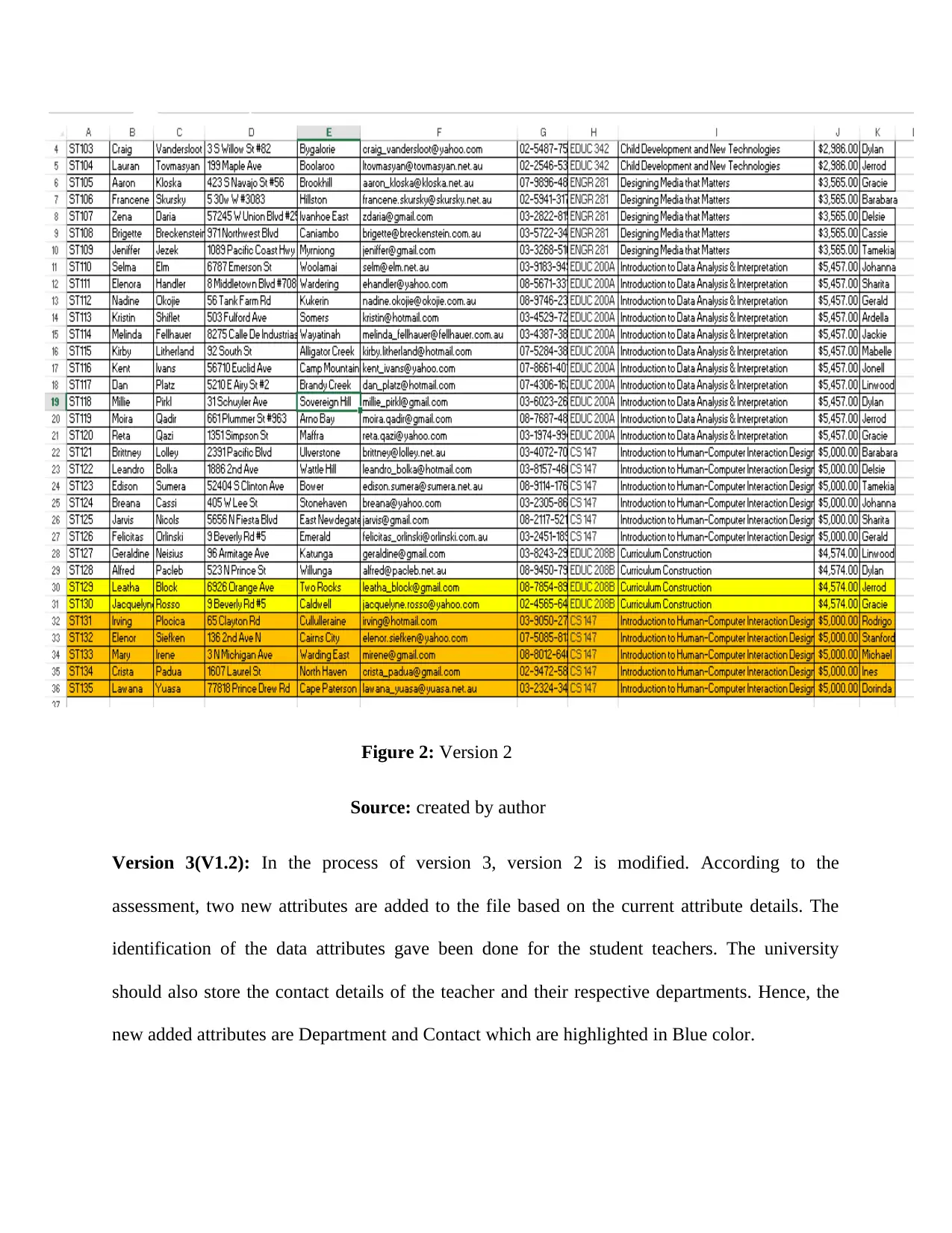
Figure 2: Version 2
Source: created by author
Version 3(V1.2): In the process of version 3, version 2 is modified. According to the
assessment, two new attributes are added to the file based on the current attribute details. The
identification of the data attributes gave been done for the student teachers. The university
should also store the contact details of the teacher and their respective departments. Hence, the
new added attributes are Department and Contact which are highlighted in Blue color.
Source: created by author
Version 3(V1.2): In the process of version 3, version 2 is modified. According to the
assessment, two new attributes are added to the file based on the current attribute details. The
identification of the data attributes gave been done for the student teachers. The university
should also store the contact details of the teacher and their respective departments. Hence, the
new added attributes are Department and Contact which are highlighted in Blue color.
Paraphrase This Document
Need a fresh take? Get an instant paraphrase of this document with our AI Paraphraser
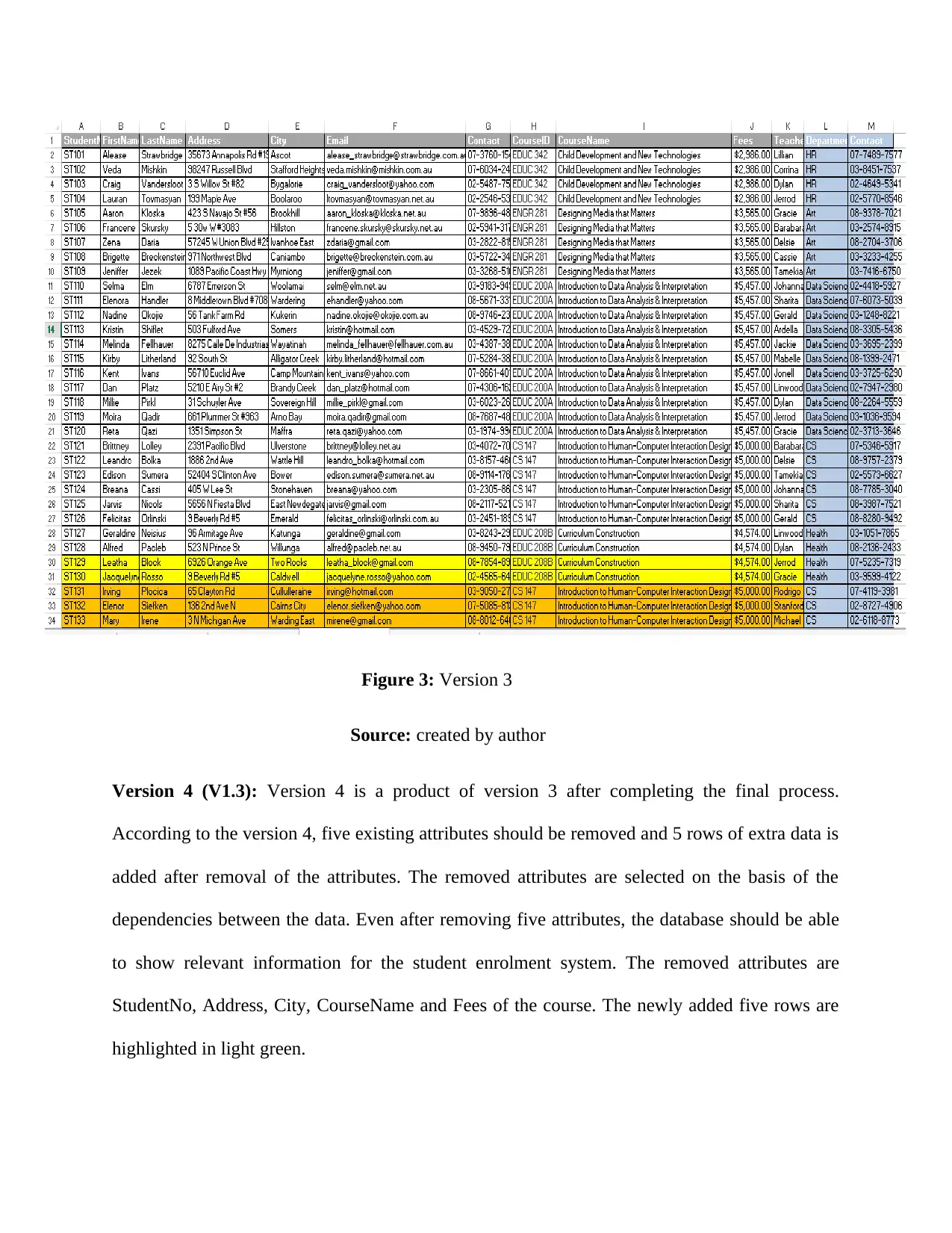
Figure 3: Version 3
Source: created by author
Version 4 (V1.3): Version 4 is a product of version 3 after completing the final process.
According to the version 4, five existing attributes should be removed and 5 rows of extra data is
added after removal of the attributes. The removed attributes are selected on the basis of the
dependencies between the data. Even after removing five attributes, the database should be able
to show relevant information for the student enrolment system. The removed attributes are
StudentNo, Address, City, CourseName and Fees of the course. The newly added five rows are
highlighted in light green.
Source: created by author
Version 4 (V1.3): Version 4 is a product of version 3 after completing the final process.
According to the version 4, five existing attributes should be removed and 5 rows of extra data is
added after removal of the attributes. The removed attributes are selected on the basis of the
dependencies between the data. Even after removing five attributes, the database should be able
to show relevant information for the student enrolment system. The removed attributes are
StudentNo, Address, City, CourseName and Fees of the course. The newly added five rows are
highlighted in light green.
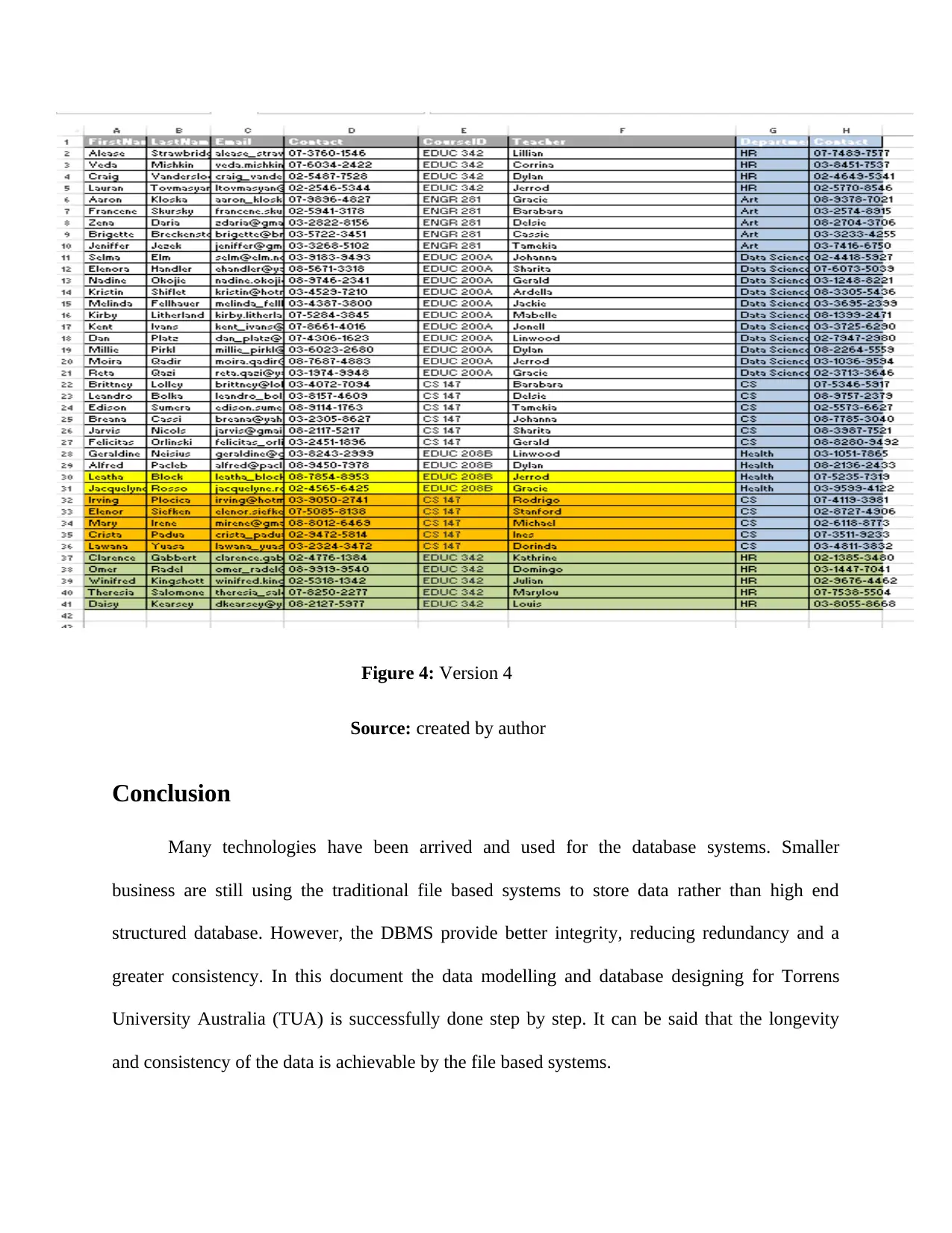
Figure 4: Version 4
Source: created by author
Conclusion
Many technologies have been arrived and used for the database systems. Smaller
business are still using the traditional file based systems to store data rather than high end
structured database. However, the DBMS provide better integrity, reducing redundancy and a
greater consistency. In this document the data modelling and database designing for Torrens
University Australia (TUA) is successfully done step by step. It can be said that the longevity
and consistency of the data is achievable by the file based systems.
Source: created by author
Conclusion
Many technologies have been arrived and used for the database systems. Smaller
business are still using the traditional file based systems to store data rather than high end
structured database. However, the DBMS provide better integrity, reducing redundancy and a
greater consistency. In this document the data modelling and database designing for Torrens
University Australia (TUA) is successfully done step by step. It can be said that the longevity
and consistency of the data is achievable by the file based systems.
⊘ This is a preview!⊘
Do you want full access?
Subscribe today to unlock all pages.

Trusted by 1+ million students worldwide
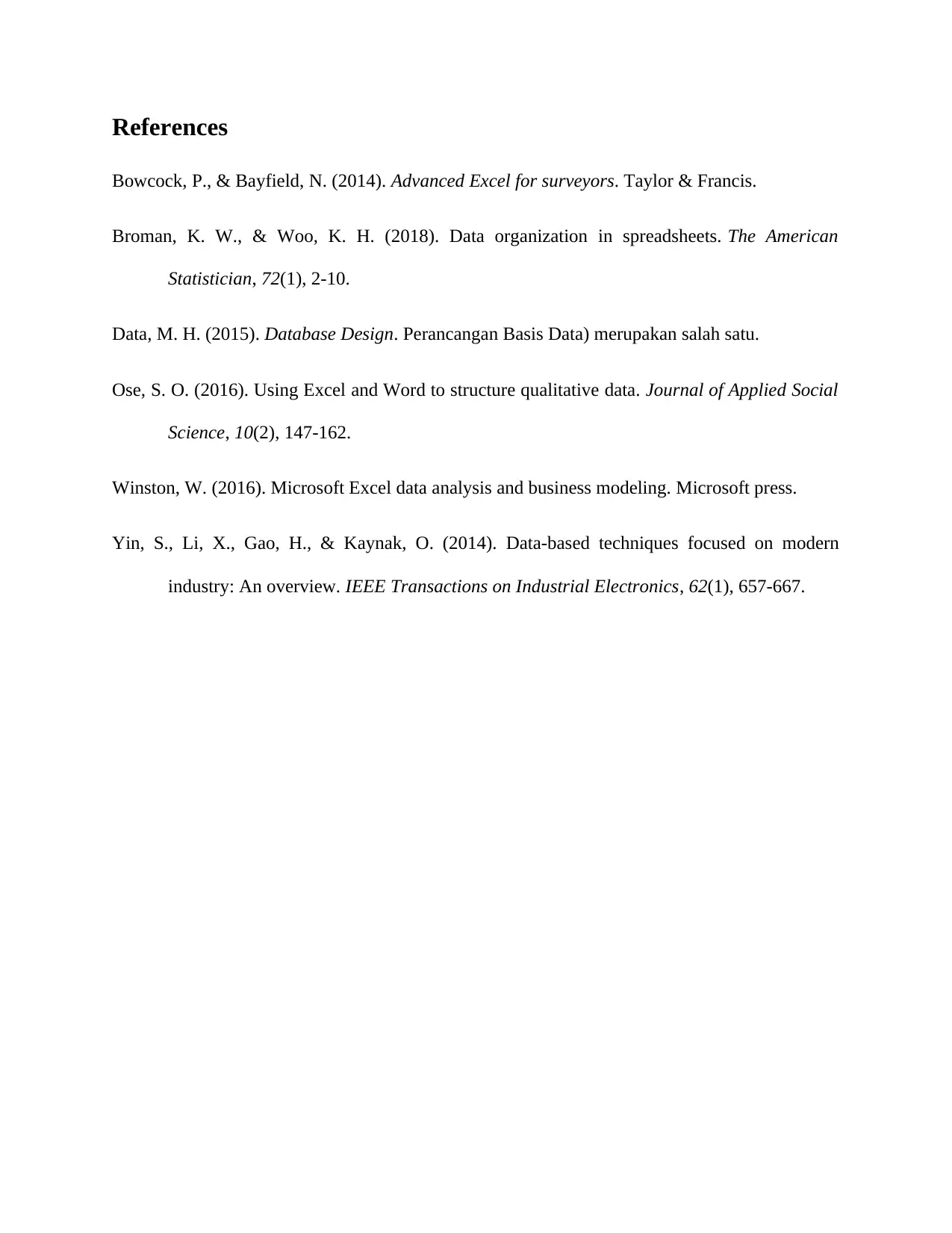
References
Bowcock, P., & Bayfield, N. (2014). Advanced Excel for surveyors. Taylor & Francis.
Broman, K. W., & Woo, K. H. (2018). Data organization in spreadsheets. The American
Statistician, 72(1), 2-10.
Data, M. H. (2015). Database Design. Perancangan Basis Data) merupakan salah satu.
Ose, S. O. (2016). Using Excel and Word to structure qualitative data. Journal of Applied Social
Science, 10(2), 147-162.
Winston, W. (2016). Microsoft Excel data analysis and business modeling. Microsoft press.
Yin, S., Li, X., Gao, H., & Kaynak, O. (2014). Data-based techniques focused on modern
industry: An overview. IEEE Transactions on Industrial Electronics, 62(1), 657-667.
Bowcock, P., & Bayfield, N. (2014). Advanced Excel for surveyors. Taylor & Francis.
Broman, K. W., & Woo, K. H. (2018). Data organization in spreadsheets. The American
Statistician, 72(1), 2-10.
Data, M. H. (2015). Database Design. Perancangan Basis Data) merupakan salah satu.
Ose, S. O. (2016). Using Excel and Word to structure qualitative data. Journal of Applied Social
Science, 10(2), 147-162.
Winston, W. (2016). Microsoft Excel data analysis and business modeling. Microsoft press.
Yin, S., Li, X., Gao, H., & Kaynak, O. (2014). Data-based techniques focused on modern
industry: An overview. IEEE Transactions on Industrial Electronics, 62(1), 657-667.
1 out of 10
Related Documents
Your All-in-One AI-Powered Toolkit for Academic Success.
+13062052269
info@desklib.com
Available 24*7 on WhatsApp / Email
![[object Object]](/_next/static/media/star-bottom.7253800d.svg)
Unlock your academic potential
Copyright © 2020–2025 A2Z Services. All Rights Reserved. Developed and managed by ZUCOL.





